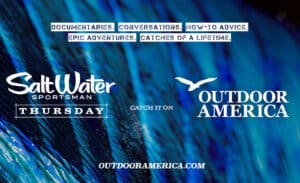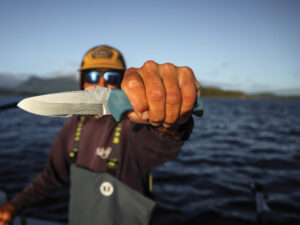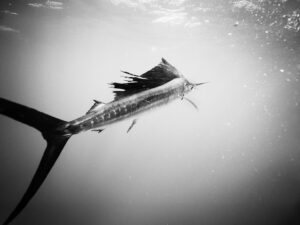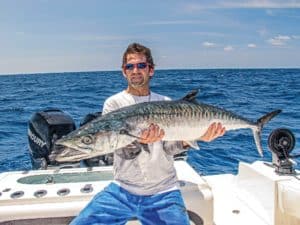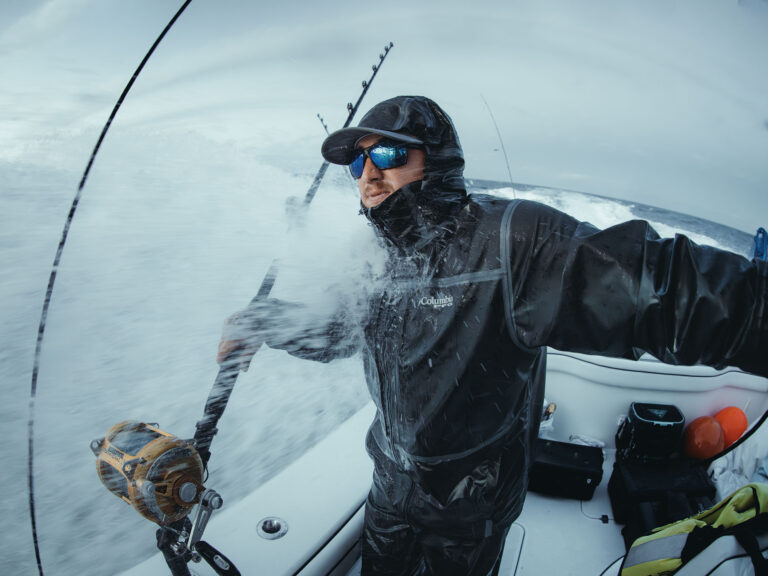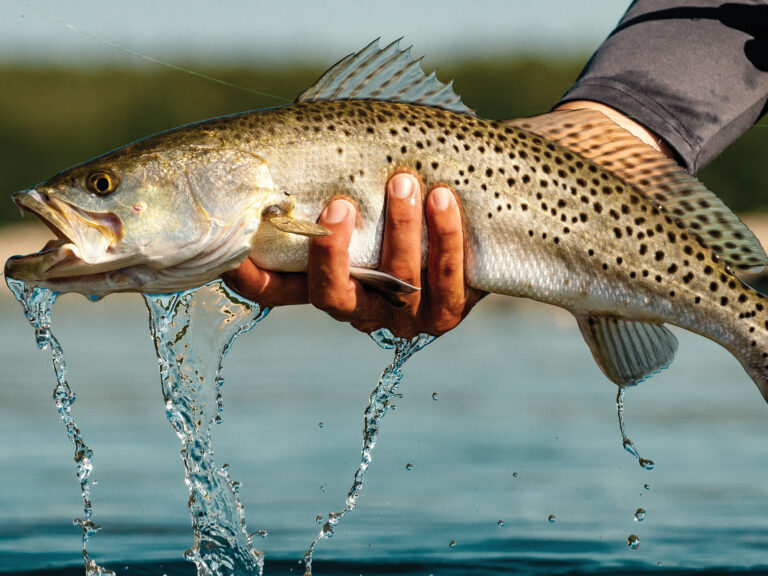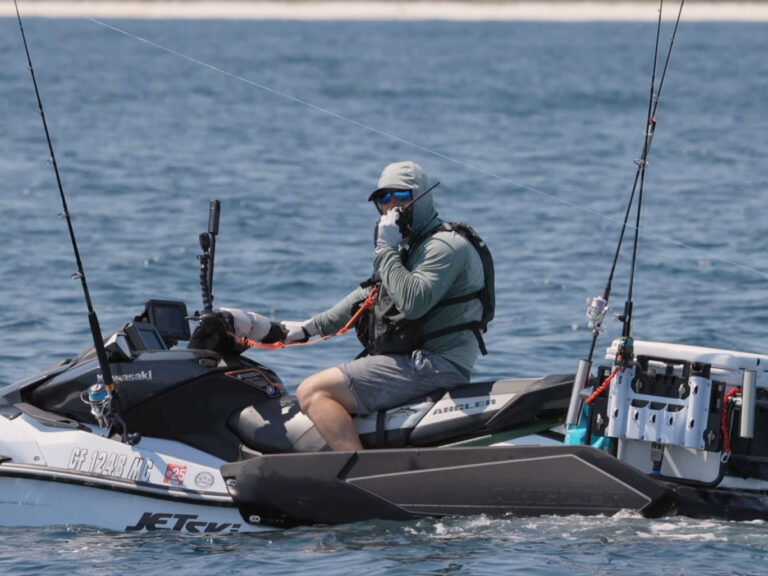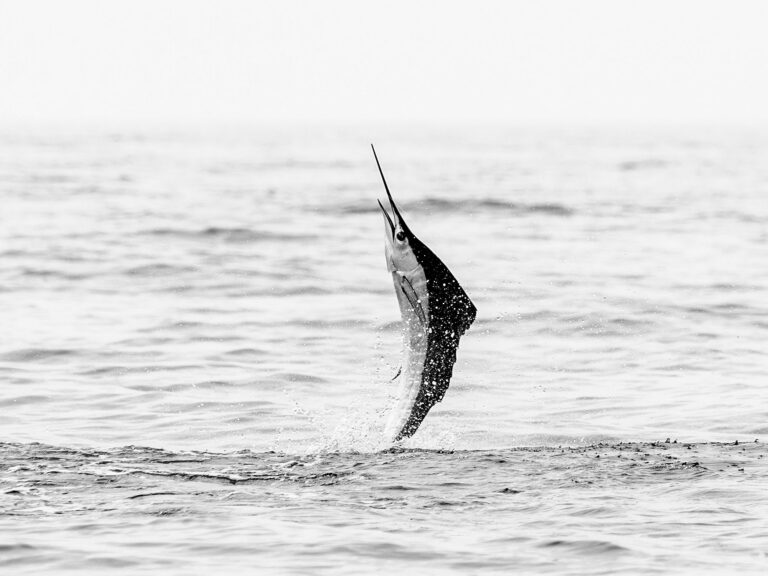
The fight was on and we had ringside seats. Drifting off Red Rock, a small island in San Francisco Bay, my friend Bill Boyce was whooping and hollering like a kid as he applied the brakes on a stubborn striped bass digging for the bottom. His was the trip’s first hookup, but within seconds, Capt. Tommy Glasser and I joined in the fun, completing the triple-header.
Bill had brought his TV show crew to northern California to shoot a striper episode, and the action didn’t disappoint. By the time the sun set, we had released well over 100 striped bass ranging in size from 4 to 12 pounds. The fish were not trophies, but when you’re vertical jigging with light gear, they’re an absolute ball.

Going Vertical
The development of superbraids has allowed anglers to gear down. The lighter tackle, coupled with lifelike metal jigs now available in countless color schemes, sizes and weights, enable us to probe the depths and catch a wide array of species, including the striped bass that invade Frisco Bay’s rock reefs and bars from spring through autumn. Such structures rise from the bottom enough to create current upwellings that stack up bait and attract feeding striped bass. These ambush zones are prime target areas for vertical jigging and, depending on where you are in the bay, both incoming and outgoing tides produce. But the best action usually happens on tides that rise or fall at least 5 feet.

1.) Acme Kastmaster spoon
2.) Luhr Jensen Krocodile spoon
3.) Hopkins Shorty Hammered spoon
4.) Luhr Jensen Crippled Herring
5.) P-Line Laser Minnow Angelo Cuanang
Tackle and Lures
A quality one-piece, 7-foot conventional or spinning rod with a matching reel loaded with 30- to 50-pound braid is ideal for the task. I connect a 2½-foot length of 30-pound fluorocarbon to the braid with a swivel, and then attach a snap on the other end to change lures more quickly.
There’s a wide selection of jigs and spoons well suited for vertical jigging, but I prefer those that mimic natural baits such as anchovies, sardines, jack smelt and shiner perch. Luhr Jensen Crippled Herring and Krocodile spoons, Acme Kastmaster and Hopkins Shorty spoons, P-Line Laser Minnows and Megabait lures are all excellent choices, and weights from 1 to 4 ounces cover the range of depths you’ll encounter in San Francisco Bay.

Drift, Drop and Hop
The presentation is easy. I look for defined rip lines, set up about 50 yards upstream and put the motor in neutral. Then I cast down-current, a short distance from the boat, and allow the jig to drop freely. By the time the boat begins to approach the upside of the reef or hump I’m targeting, the jig is in the strike zone and the line angle is perfectly vertical or close to it.
When I feel the jig tick bottom, I snap the rod tip upward about 2 feet and immediately allow the lure to settle back down and tick bottom again. As the boat begins to drift over the structure, I adjust for the depth change by picking up some line before continuing to bounce the jig. When working spots in 15 to 20 feet, 1 to 2 ounces will do, but in spots where the depth drops to 40 feet or more, I favor 3- to 4-ounce jigs.
Once you drift over a spot where the depth drops dramatically, pick up the lines, run back up-current, and set up for a new drift.

Suspended Fish
Watch your depth finder closely. Though you often find fish stacked up on the bottom, sometimes stripers hang much higher in the water column and even push bait to the surface, triggering bird activity. When that happens, keep tabs on your line as the jig drops and immediately strike on any pause or hesitation. If you don’t get bit by the time the jig gets near the bottom, hop it all the way up to the boat.
Rips and Craggy Bottoms
Striped bass sit on the higher point of a reef, bar or hump and pick off prey during tidal movement. In popular areas, like The Brothers and The Sisters islands, Raccoon Strait, the Rock Pile, and the sandbars south of the Oakland Bay Bridge, defined rip lines form on the surface during incoming tides, pointing out productive bottom and helping anglers set up their drifts. Keep in mind that places like the Rock Pile and the south tower at the Golden Gate Bridge have craggy contours that will claim lures allowed to drag on the bottom. So start hopping that jig the moment it ticks bottom.

Dissecting the Bay
The Brothers and The Sisters islands in the north part of San Francisco Bay are favorites of small-skiff anglers and yield tons of smaller fish. The middle bay holds a number of productive zones that attract larger fish, especially during summer and fall. Red Rock and Southampton Shoals (just south) are two of the more consistent producers. The reef between Angel Island and Tiburon, known as Raccoon Strait, is one of my favorites. West by northwest of infamous Alcatraz Island, the Rock Pile and Harding Rock are also excellent. Mel’s Reef and Blossom Rock are also hot spots, slightly southwest and southeast of Alcatraz respectively. Looking west to the famed Golden Gate Bridge, the hard reefs at the south tower are another striper hangout. Down south, a short distance below the Oakland Bay Bridge, more hangouts include the hard bars at the west and east sides of the bridge.
SWS Planner
What: Striped bass. In San Francisco Bay, anglers can keep two per day 18 inches or larger.
When: Spring through fall
Where: San Francisco Bay launch ramps at Loch Lomond Marina in San Rafael, Richmond Marina in Richmond, and Berkeley Marina in Berkeley
Who: Anglers aboard 17- to 25-foot boats.
The following guides can put you on fish and show you the ropes:
- Capt. Chris Smith, 510-322-0493
- Capt. Trent Slate, 415-307-8582
- Capt. Don Franklin, 510-703-4148
SWS Tackle Box
- Rods: One-piece, 7-foot spinning or conventional rated for 10- to 20-pound line, like the Cousins LSW 703C and LSW 703S or equivalent
- Reels: Matching spinning or conventional with smooth drag and at least 200-yard line capacity, like the Penn Slammer 360 and 965 levelwind or equivalent
- Line: 30- to 50-pound P-Line superbraid or equivalent
- Leader: 2 feet of 40-pound-test P-Line fluorocarbon with appropriate swivel and snap placed at the respective ends
- Lures: Luhr Jensen Crippled Herring and Krocodile spoons, Acme Kastmaster spoons, P-Line Laser Minnows, and Megabait lures in natural baitfish colors from 1 to 4 ounces
Fast Facts for Success
- Pick a Spot: Use a chart to identify reefs, humps and bars where baitfish and stripers are likely to congregate.
- Drift and Drop: Set up up-current of the structure and drift toward it. Cast the lure ahead of the boat and let it drop freely.
- Pull the Trigger: Keep tabs on the line as the lure falls to the bottom. If you detect even a slight pause, set the hook.

